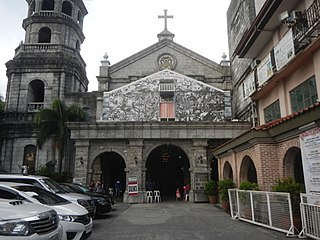
Rizal, officially the Province of Rizal, is a province in the Philippines located in the Calabarzon region in Luzon. Its capital is the city of Antipolo. It is about 16 kilometres (9.9 mi) east of Manila. The province is named after José Rizal, one of the main national heroes of the Philippines. Rizal is bordered by Metro Manila to the west, Bulacan to the north, Quezon to the east, and Laguna to the southeast. The province also lies on the northern shores of Laguna de Bay, the largest lake in the country. Rizal is a mountainous province perched on the western slopes of the southern portion of the Sierra Madre mountain range.

Pateros, officially the Municipality of Pateros, is the lone and 1st class municipality in Metropolitan Manila, Philippines. According to the 2015 census, it has a population of 63,643 people.

Taguig, officially the City of Taguig, is a 1st class highly urbanized city in Metropolitan Manila, Philippines. According to the 2015 census, it has a population of 804,915 people. The city is known for the Bonifacio Global City, one of the leading financial and lifestyle districts of the country, Arca South, a planned unit development located at the site of the former Food Terminal Incorporated (FTI) in Western Bicutan, and Bonifacio Capital District (BCD), where the future buildings of the Senate of the Philippines, the Supreme Court, and the Court of Appeals will be located. Taguig is also home of major shopping centers such as SM Aura Premier and Market! Market!, government agencies of Department of Science and Technology and Department of Energy, and notable memorial parks Manila American Cemetery and the Libingan ng mga Bayani.

Bonifacio Global City is a financial and lifestyle district in Taguig, Metro Manila, Philippines. It is located 11 km (6.8 mi) south-east of the center of Manila. The district experienced commercial growth following the sale of military land by the Bases Conversion and Development Authority (BCDA). The entire district used to be the part of the main Philippine Army camp.
The legislative districts of Manila are the representations of the highly urbanized city of Manila in the various national legislatures of the Philippines. The city is currently represented in the lower house of the Congress of the Philippines through its first, second, third, fourth, fifth, and sixth congressional districts.
The Legislative district of Las Piñas–Muntinlupa was the combined representation of the Metropolitan Manila municipalities of Las Piñas and Muntinlupa in the lower house of the Congress of the Philippines from 1987 to 1998.
The legislative district of Muntinlupa is the representation of the highly urbanized city of Muntinlupa in the Congress of the Philippines. The city is currently represented in the lower house of the Congress through its lone congressional district.
The legislative districts of Rizal are the representations of the province of Rizal in the various national legislatures of the Philippines. The province is currently represented in the lower house of the Congress of the Philippines through its first and second congressional districts.
The legislative district of San Juan–Mandaluyong was the combined representation of the Metropolitan Manila municipalities of Mandaluyong and San Juan in the Regular Batasang Pambansa (1984–1986) and the lower house of the Congress of the Philippines (1987–1995).
The legislative districts of Makati are the representations of the highly urbanized city of Makati in the various national legislatures of the Philippines. The city is currently represented in the lower house of the Congress of the Philippines through its first and second districts.
The legislative district of Pateros–Taguig is the combined representation of the independent municipality of Pateros and eastern part of the highly urbanized city of Taguig in the Congress of the Philippines. The city and municipality are currently represented in the lower house of the Congress through their lone congressional district.
The Legislative district of Las Piñas–Parañaque was the combined representation of the Metropolitan Manila municipalities of Las Piñas and Parañaque in the Regular Batasang Pambansa from 1984 to 1986.
The Legislative district of Taguig–Pateros–Muntinlupa was the combined representation of the Metropolitan Manila municipalities of Muntinlupa, Pateros and Taguig in the Regular Batasang Pambansa from 1984 to 1986.

Taguig National High School commonly abbreviated as T.N.H.S. is a state-owned secondary high school institution in the Philippines. The campus lies at Imelda Romualdez Marcos Road abbreviated as I.R.M. Road and situated at both Barangay Maharlika Village and Barangay New Lower Bicutan.
Metro Manila, the capital region of the Philippines, is a large metropolitan area that has several levels of subdivisions. Administratively, the region is divided into seventeen primary local government units with their own separate elected mayors and councils who are coordinated by the Metropolitan Manila Development Authority, a national government agency headed by a chairperson directly appointed by the Philippine president. The cities and municipality that form the region's local government units are further divided into several barangays or villages which are headed by an elected barangay captain and barangay council.

The following outline is provided as an overview of and topical guide to Metro Manila:

The following is an alphabetical list of articles related to the Philippine capital region of Metro Manila.

Fort Bonifacio is one of the 28 barangays of Taguig, Metro Manila, Philippines. The financial district of Bonifacio Global City, the Fort Bonifacio military camp and the Manila American Cemetery are under the jurisdiction of the barangay.

The territorial extents of the cities of Makati and Taguig, and the municipality of Pateros is disputed by their local governments particularly the Fort Bonifacio area which includes the financial district of Bonifacio Global City.










